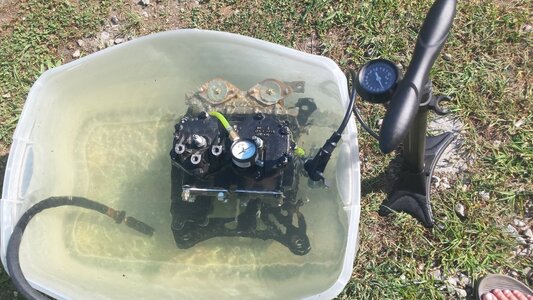WaveBlaster 701 with dual 44 SBN's on Riva intake.
I have been chasing a run away condition. I had a rear seal pushed out a bit so I replaced all the crank seals and "assumed" I was all good. Reinstalled the engine and had an immediate run away again the minute I fired it up in the shop. Pulled the engine and made block off plates and built a set up to pressure test the engine. (lesson learned to always pressure test....) The exhaust plates worked perfect, no leaks. The first set of intake plates leaked massively. The gaskets I had on the engine were from Riva and thick and in good visual condition. They leaked, so I ordered 12 off ebay from somebody in AZ and they leaked... these gaskets were thin. Tried grease on both types and it helped but didn't stop the leak. The plates would rock a little on the intake so I built another set from different material (stop sign) and ended up with the same results. These had a little rock to them also on the intake and I still had massive leaks. I should add, all the block off plates I made seemed to have a little rock even on a glass surface. I ended up going to Advance Auto and getting 1 3/4" expansion plugs which fit perfect in the intake and sealed it off completely. At this point I still had a slow leak and couldn't find it with soap and water so I ended up submerging the engine all the way up to the head in water to test it only to find my PSI gauge had an internal leak when I dipped it underwater. But otherwise the only thing I noticed from the engine was a very very small bubble escaping about every 20 or so seconds from one of the pry points at the base of the rear cylinder. So small that I can't imagine it could suck enough air through to cause a run away.
So all that leads me to my question, has anybody ever had an intake warp to the point it will not seal to the base of the carbs? I don't know what could cause that casting to lose it's flatness but i am running out of ideas. I had this thing underwater for about 5 minutes with no noticeable leaks from the engine or intake so I am now focusing on the intake where the carbs mount. I am going to replace the test gauge today and at this point plan to test it with the carbs on and the top of the carbs plugged but wanted to see if anybody has dealt with a situation like this. Thanks.
I have been chasing a run away condition. I had a rear seal pushed out a bit so I replaced all the crank seals and "assumed" I was all good. Reinstalled the engine and had an immediate run away again the minute I fired it up in the shop. Pulled the engine and made block off plates and built a set up to pressure test the engine. (lesson learned to always pressure test....) The exhaust plates worked perfect, no leaks. The first set of intake plates leaked massively. The gaskets I had on the engine were from Riva and thick and in good visual condition. They leaked, so I ordered 12 off ebay from somebody in AZ and they leaked... these gaskets were thin. Tried grease on both types and it helped but didn't stop the leak. The plates would rock a little on the intake so I built another set from different material (stop sign) and ended up with the same results. These had a little rock to them also on the intake and I still had massive leaks. I should add, all the block off plates I made seemed to have a little rock even on a glass surface. I ended up going to Advance Auto and getting 1 3/4" expansion plugs which fit perfect in the intake and sealed it off completely. At this point I still had a slow leak and couldn't find it with soap and water so I ended up submerging the engine all the way up to the head in water to test it only to find my PSI gauge had an internal leak when I dipped it underwater. But otherwise the only thing I noticed from the engine was a very very small bubble escaping about every 20 or so seconds from one of the pry points at the base of the rear cylinder. So small that I can't imagine it could suck enough air through to cause a run away.
So all that leads me to my question, has anybody ever had an intake warp to the point it will not seal to the base of the carbs? I don't know what could cause that casting to lose it's flatness but i am running out of ideas. I had this thing underwater for about 5 minutes with no noticeable leaks from the engine or intake so I am now focusing on the intake where the carbs mount. I am going to replace the test gauge today and at this point plan to test it with the carbs on and the top of the carbs plugged but wanted to see if anybody has dealt with a situation like this. Thanks.
Attachments
Last edited:

